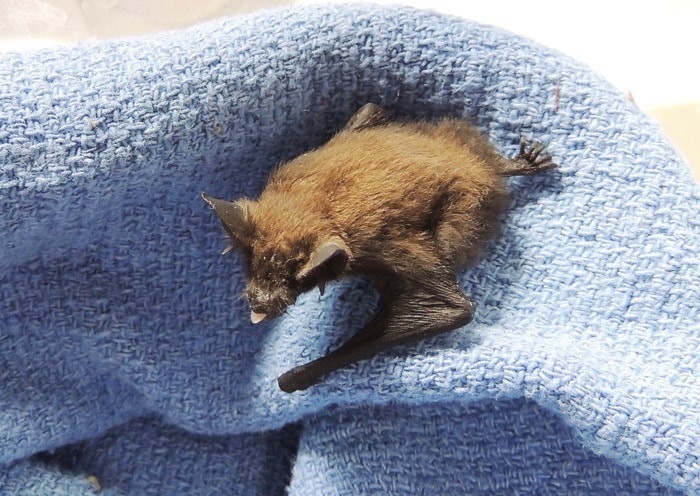Often mistaken for birds, one of the coolest mammals are bats.
Often regarded as evil, sinister and spooky bats are incredible little animals. There are more than 1,000 species worldwide, 16 of these species call B.C. home and 10 species live on Vancouver Island.
The local species include the little brown bat and the big brown bat, the Keen bat, silver haired and Townsend bat.
Bats in general are covered in fur, have extremely large ears, a tail, and 32 sharp teeth that can bite; their faces resemble a crinkled bulldog, their bodies that of a mouse and wings that are aerodynamic.
Bat wings consist of a thin hairless membrane supported by elongated hands and fingers and are also attached to the ankles leaving the feet free.
Each wing is equipped with a protruding thumb complete with a claw that enables the bat to hang upside-down when at roost and allows the babies to crawl on the ground or climb back up a tree.
The membranes are quite restrictive to the bat and they compensate by having their elbows and knees rotate the opposite way to ours.
Like all mammals bats are warm blooded and give birth to live young which are nursed with milk produced by the female.
Little brown bats are one of the more common species found on Vancouver Island and are also one of the smallest with a body length of 3.5 inches and a 10-inch wingspan. In comparison the big brown bat has a body length of 6.5 inches and a 13-inch wing span.
Little brown bat bodies are covered in grey or brown fur, their forearms and long fingers are attached to a black membrane which stretches back and is attached to the inner legs and covers the tail.
The membranes form “wings” that allow the bat to fly, and are also used to crawl and groom, the leg membranes form an “apron” which acts as a receptacle to catch the newborn babies.
Habitats for these bats include trees, buildings, under bark or wood and in caves where they will either roost alone or in large colonies during the day. Some bats, including the little brown bats, go into hibernation during the winter occasionally waking up for a drink, while other species migrate.
All bats are equipped with remarkable hearing and they have very large ears which collect and channel sound to their brain. Echo location is used by bats and sets them apart from any other species of mammal; this is truly a technological feat.
Bats are able to emit noises through their mouths and noses bouncing the sound off an object, the returning echo is collected by the ears, and after analysis, the brain informs the bat if the object if food or foe.
Another fascinating fact about bats is the food they choose to eat. There are many very specialized feeders, some only eat fruit and flowers and in many desert areas are the only creatures that will aid in nocturnal pollination of trees or cacti.
Other bats prefer insects, frogs, small birds or smaller bats. Others, like the vampire bats, that are not found locally, feed on animal or human blood.
Little brown bats prefer insect and are particularly fond of mosquitoes. During late summer and early fall they will go on a feeding frenzy consuming half their body weight in one night to increase their body fat in preparation for the winter hibernation.
Reproduction is yet another unique process. Mating takes place in the fall just before hibernation when the female has stored her extra body fat in order to survive the winter.
After mating the female separates herself from the male who has no further use for her, she stores the sperm until conditions are favourable for fertilization.
When delivery is imminent the female creates an “apron” with her tail and lower wing membranes to catch the emerging “pups.”
Once delivered she bites the umbilical cord allowing the pups to crawl up and attach themselves to a nipple with their sharp baby teeth. For the first two weeks until their eyes are open and they grow fur, the pups are enfolded in her wings and cling to her even during her flights to catch food. When they become too heavy they remain in the roost until they are able to fly and feed themselves.
In the last few weeks Mountainaire Avian Rescue Society (MARS) answered six calls from the Courtenay Recreation Centre when roosting little brown bats were disturbed during renovations to the shake roof.
The bats like to cling to the cracks of tree bark and shakes seemed a good substitute. Please DO NOT attempt to rescue a bat, DO NOT touch them as this means they will have to be killed.
They are highly susceptible to rabies and even if they have no symptoms (aggressive behaviour, or out in the daytime) they can be carriers of this nasty disease. If your cat catches a bat take the cat to the vet for possible quarantine in case the bat was rabid; cats should not be able to catch a healthy bat.
On the positive, bats are great insect controllers and will happily live in manmade bat boxes. Keep an eye out at dusk you too may see a bat or two.
On arrival at MARS, bats are only treated by experienced volunteers who have had rabies shots.
To report injured wildlife or for advice on how to handle a wildlife problem please call 1-800-304-9968, all other calls 250-337-2021 or visit www.wingtips.org
